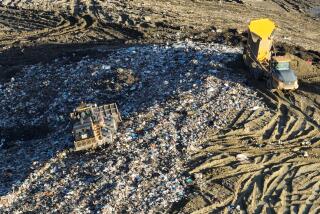Garbage House : Trashy housing takes on whole new meaning as builders experiment with ways to use recycled materials
- Share via
The handsome Colonial-style home shown at right features four bedrooms, two baths and two powder rooms, along with a two-car garage. It would fit perfectly in almost any upscale subdivision where prices run in the high $200,000s.
But wait till you see what it’s made from.
The National Assn. of Home Builders, which created the home at its Research Center in Bowie, Md., formally calls it the Resource Conservation Research House. Less formally, it’s known as the “Garbage House.”
Step inside the 3,600-square-foot house, and it’s the stuff dream dwellings are made of--a wood-burning fireplace, spiffy track lighting, a Jacuzzi in the master bath.
But in fact, you’re treading on a high-priced scrap heap. You’re also walking into the future, for the entire place, subflooring to attic, amounts to one inspired riff on the theme of recycling and energy conservation.
And the future, according to those farsighted folks at the Research Center, is just around the corner. As old-growth forests dwindle, the price of lumber is skyrocketing. Energy costs will soar. And landfills are going to be maxing out all over.
Do not fear: Garbage House is here. The frame is steel, most of it recovered from junkyard cars and dismantled bridges. An added bonus: Termites are foiled forever. The siding might look like ordinary clapboard, but it’s really made of sawmill wastes and wood chips. And a layer of insulation sandwiched beneath that siding contains 20% recycled polystyrene packaging.
Then there’s the nifty solar collector beside the deck in the back yard. It’s fitted with a solar panel (heating 80% of the house’s hot water) and a photovoltaic panel that powers the landscaping lights and the security system and provides backup electricity should a power failure occur.
The interior holds its surprises too. Overhead ceiling tiles contain recycled newsprint. The double-paned windows are state-of-the-art energy efficient. Even the heat pump is state of the art, drawing warmth from the earth via copper pipes buried under the lawn.
You’ll find even more innovations described on the above illustration. Don’t be surprised, though, if persistence is required to track down the house’s environmentally friendly components: some products are prototypes, others are on the market but still not easy to come by.
* Reprinted with permission of Smithsonian Magazine, copyright 1994 Smithsonian Institution. All rights reserved.
More to Read
Sign up for Essential California
The most important California stories and recommendations in your inbox every morning.
You may occasionally receive promotional content from the Los Angeles Times.






